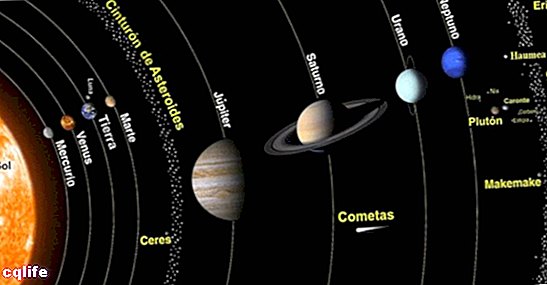We explain what the solar system is and what its characteristics are. How it is formed and what are the planets of the solar system.

What is the solar system?
The Solar System is the planetary context in which our planet Earth: a circuit where eight planets constantly orbit a single star, the Sun.
Of course, ours is not the only planetary system that exists. There are systems of dynamic forces around the gravity of one or more stars across the galaxy and from universe, so it is relatively safe to assume that incalculable such systems exist.
Our Solar System is part of the Local Interstellar Cloud, within the Local Bubble of the Orion arm, located about 28,000 light years from the bright center of our galaxy, the Milky Way. It is estimated that it was formed 4568 million years ago, as a consequence of the collapse of a molecular cloud in, giving rise to a circumstellar or protoplanetary disk, that is, a disordered set of matter surrounding the Sun in the form of rings. From there the different planets and astronomical objects of our space neighborhood would have been constituted.
The objects of the solar system, as in other planetary systems, are kept in a orbit elliptical around star largest and, therefore, more serious than the system. In our case, of course, it is the Sun, a G-type star of 1,392,000 kilometers in total diameter, which contains 99.86% of the mass total of the Solar System.
How is the solar system formed?
As has been said, at the very center of the Solar System is the Sun, a yellow dwarf star of luminosity V, and the only star that emits its own light in the whole. Eight planets of different sizes and at different distances orbit around it, tracing elliptical paths as they pass.
Similarly, there is an abundant field of asteroids, in a belt that is after Mars, and a much larger one after Neptune. In addition, there are asteroids in the rings that surround the large outer planets such as Saturn and Uranus.
Mention should also be made of natural satellites, like our Moon, or the moons of Mars: Deimos and Phobos, which are abundant on the outer planets: Jupiter and Saturn have 63 and 61 respectively, while Neptune and Uranus have 27 and 13.
Finally, there is a series of trans-Neptunian objects, the farthest from the Sun in the system, whose little impact from the sunlight makes it difficult to study, but that would hypothetically be three:
- The Kuiper Belt. A tangle of celestial bodies that orbit the Sun distantly, and from among which the kites short-term who visit us from time to time. Pluto and its satellite Charon are considered the largest objects in this group.
- The Scattered Disk. A region of space overlapping with the Kuiper Belt and extending an unknown distance away from the Sun. There would be an uncertain number of astronomical objects, estimated to be around 90.
- The Oort Cloud. A spherical cloud of celestial bodies, located almost a year sunlight, a hundred times farther than the Kuiper Belt. It is assumed that there would be between one and one hundred billion objects, which add up to a total mass five times that of the Earth.
Planets of the solar system

There are eight main planets in the solar system, divided into two groups:
- Inner planets. The closest to the sun and the smallest: Mercury, Venus, Earth and Mars. They are also called terrestrial or telluric planets, since they have a solid, concrete surface, around which there is a atmosphere (except in the case of Mercury).
- Outer planets. What are they after asteroid belt in the middle of the planetary system, gigantic and basically gaseous: Jupiter, Saturn, Neptune and Uranus. The last two are known as the Frost Giants.
There is also a set of dwarf planets, including Pluto since 2006: Ceres, Makemake, Eris and Haumea. They have enough mass to acquire a spherical shape, but not to attract or repel objects around them, so they are considered to be somewhere between planets and asteroids.
Recent studies indicate that there could be a ninth planet, provisionally called Phattie, but nothing has been confirmed about it yet.
